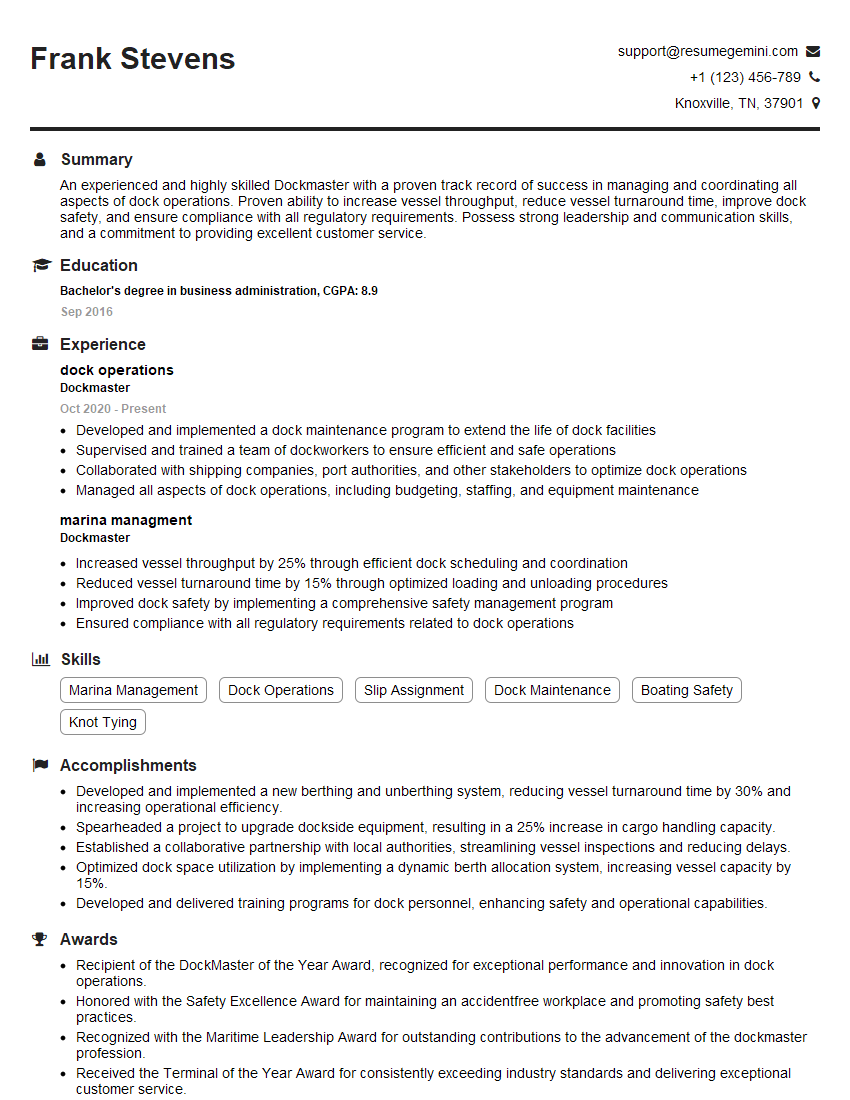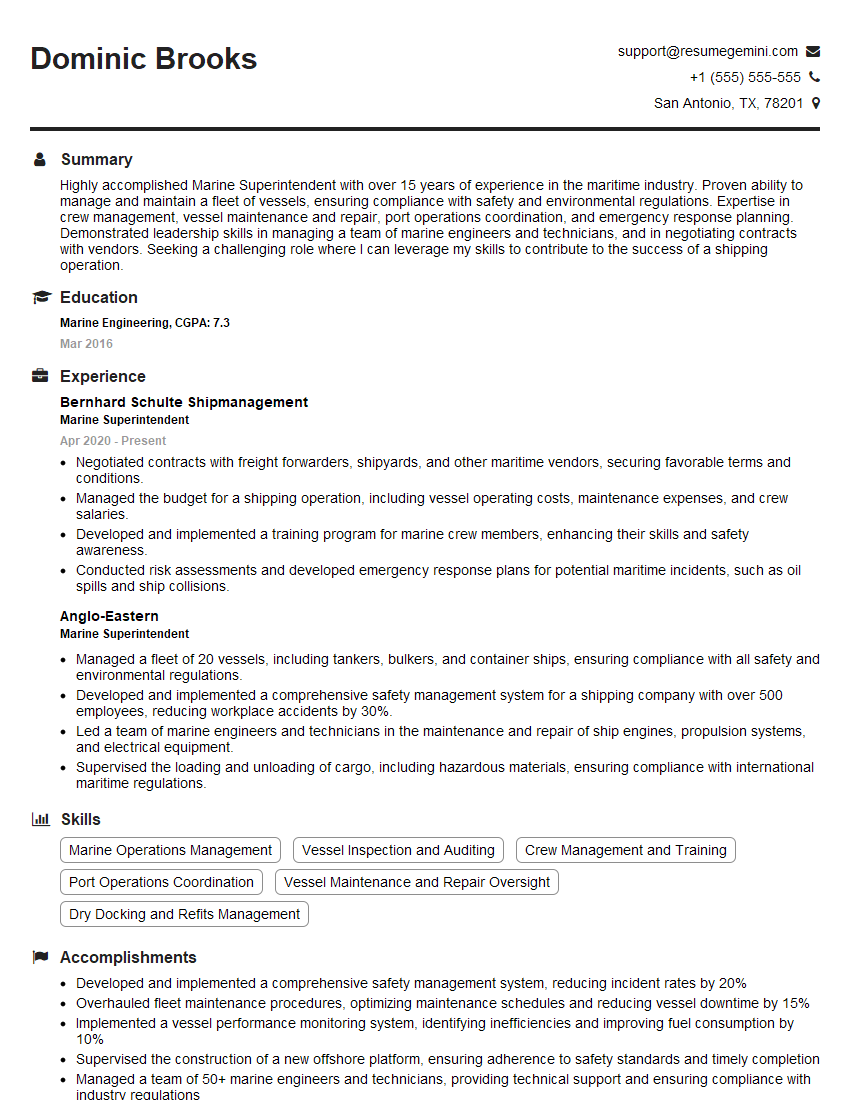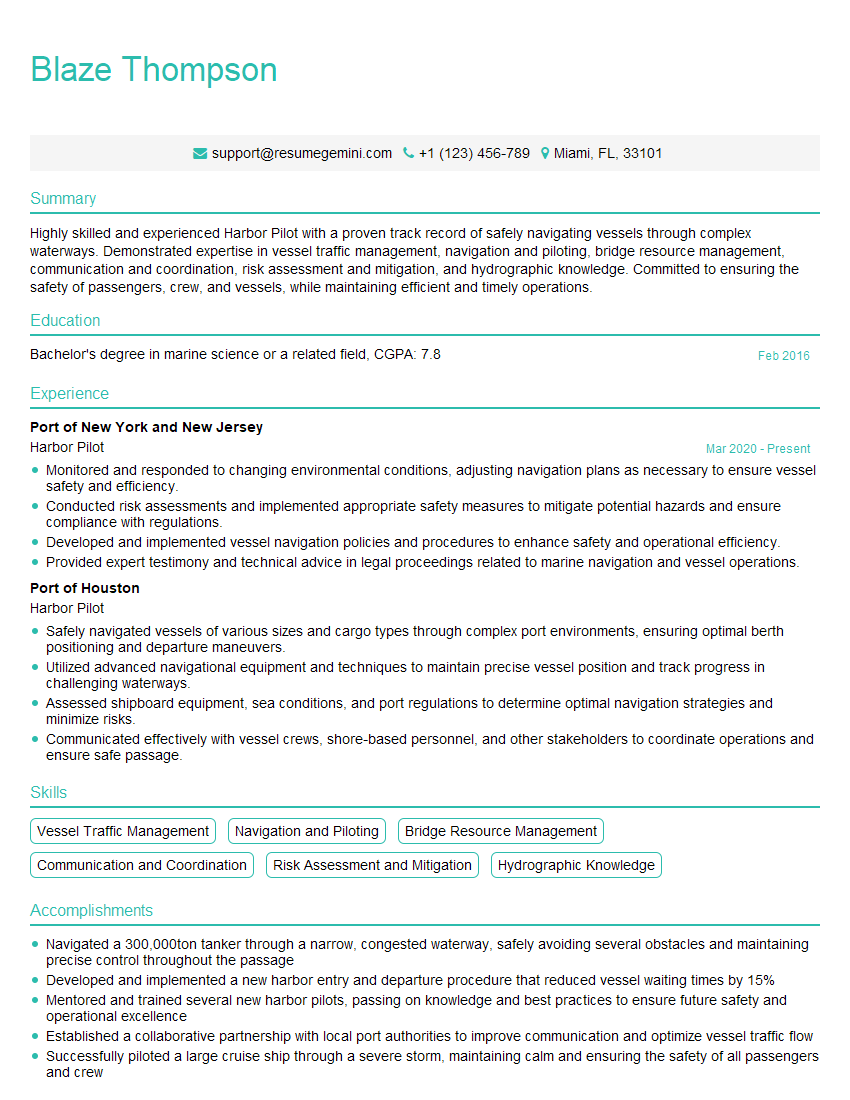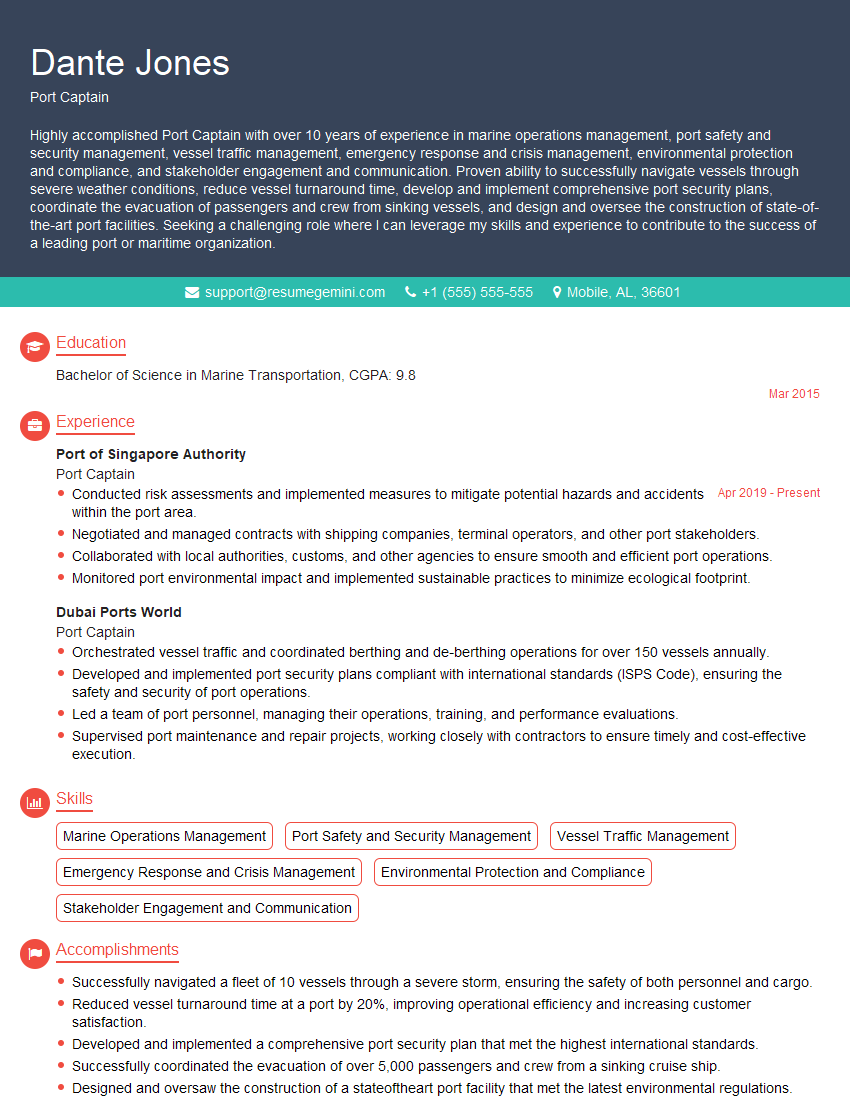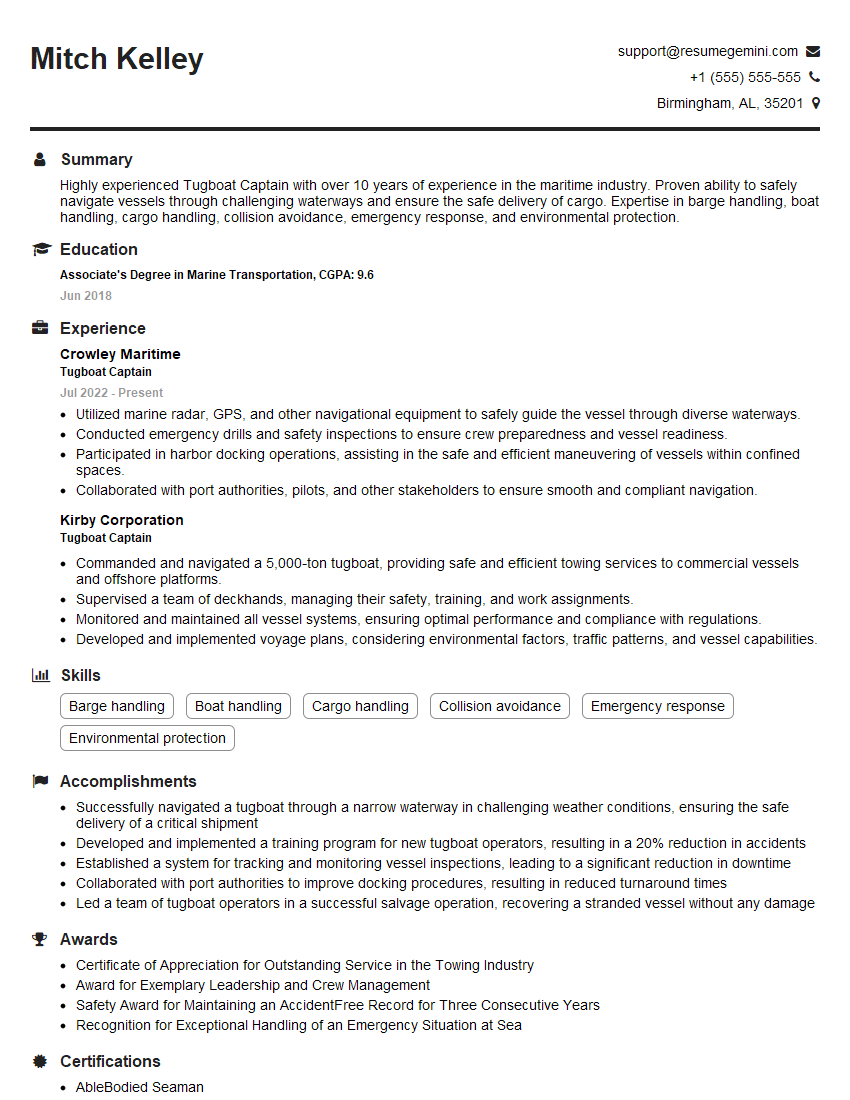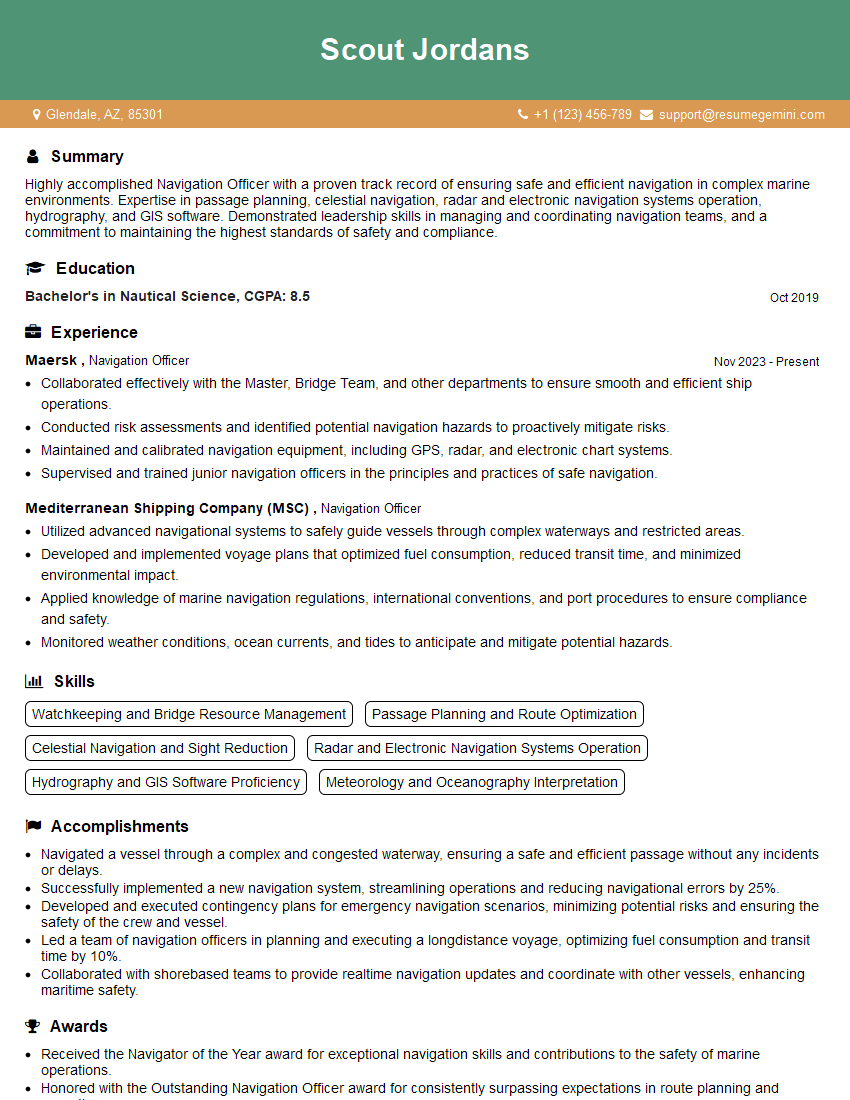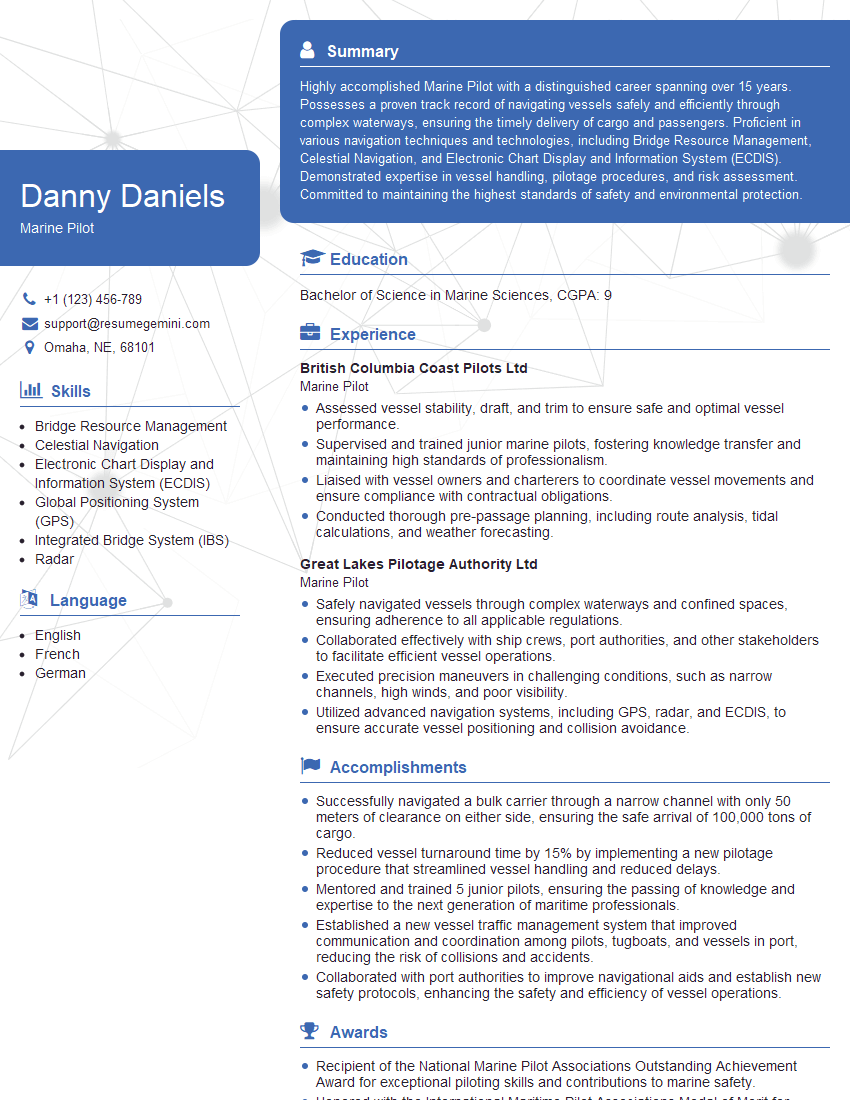Interviews are opportunities to demonstrate your expertise, and this guide is here to help you shine. Explore the essential Tanker Berthing interview questions that employers frequently ask, paired with strategies for crafting responses that set you apart from the competition.
Questions Asked in Tanker Berthing Interview
Q 1. Explain the process of a typical tanker berthing operation.
Tanker berthing is a complex, coordinated maneuver requiring precision and teamwork. It begins well before the vessel arrives at the berth. The process typically involves several stages:
- Pre-berthing planning: This includes reviewing nautical charts, weather forecasts, tide predictions, and the vessel’s characteristics (size, draft, etc.). We also coordinate with port authorities, tugboat operators, and the shore-based team.
- Approach and positioning: The tanker approaches the berth under the control of the master, guided by the pilot and assisted by tugs. The goal is to reach a designated position for the final berthing maneuver.
- Mooring operations: Once in position, mooring lines (head, breast, stern) are passed from the vessel to shore personnel. These lines are secured to bollards or mooring winches. Tugs play a crucial role in controlling the vessel’s position during this stage.
- Final adjustments and securing: Further adjustments are made to the vessel’s position using the mooring lines and tugs to ensure secure berthing. All lines are checked for tension and security.
- Post-berthing checks: A final inspection of all mooring lines and fenders is undertaken to ensure the vessel is safely berthed and there are no potential issues.
Imagine it like parking a very large, unwieldy car in a tight spot, but with the added complexities of wind, currents, and the need for flawless communication and coordination.
Q 2. Describe the different types of mooring lines used in tanker berthing.
Various mooring lines are employed during tanker berthing, each serving a specific purpose. The choice depends on factors like vessel size, berth configuration, and environmental conditions. Common types include:
- Polypropylene lines: These are relatively lightweight, strong, and easy to handle, often used for breast and stern lines.
- Steel wire ropes: Much stronger than polypropylene, ideal for head lines and situations demanding high tensile strength. They are used when maximum holding power is critical.
- Nylon lines: Offer good elasticity, helpful in absorbing sudden shocks and reducing stress on the vessel and mooring structures.
- Chain: Used for heavy-duty applications and where significant shock absorption is needed, usually in the head lines.
The diameter and length of each line are carefully selected to withstand the forces involved. For instance, head lines are often larger and stronger than breast lines to manage the vessel’s forward momentum.
Q 3. How do you assess the wind and current conditions before initiating a berthing maneuver?
Assessing wind and current conditions is paramount for safe tanker berthing. We use a combination of tools and techniques:
- Meteorological data: We consult weather forecasts, including wind speed and direction, to predict conditions during the berthing operation.
- Current charts: These provide information on the direction and strength of currents in the harbor or port area.
- On-site observation: Visual observation of wind and water movement from the vessel and the pilot station helps refine the assessment. Experienced personnel can gauge conditions with considerable accuracy.
- Anemometers and current meters: These instruments provide more precise measurements of wind speed and direction as well as water current velocity.
By analyzing this information, we determine the required tug assistance, the best approach angle, and the necessary precautions to mitigate risks associated with adverse weather or current conditions. For example, strong crosswinds may require more tugs or a slower approach speed.
Q 4. What safety procedures are critical during tanker berthing?
Safety is paramount during tanker berthing. Critical safety procedures include:
- Pre-berthing safety briefing: A comprehensive briefing covers the berthing plan, roles and responsibilities, communication protocols, and emergency procedures.
- Proper PPE: All personnel involved must wear appropriate personal protective equipment (PPE), including life jackets, safety helmets, and gloves.
- Line handling procedures: Strict adherence to safe line-handling practices to prevent injuries and damage to equipment.
- Emergency response plan: A well-defined emergency plan addresses various scenarios, such as line breakage, equipment failure, or collision.
- Regular communication: Clear and constant communication between the vessel, tugs, and shore personnel is essential to avoid mishaps.
- Fenders and protection systems: Properly placed fenders and other protection systems to mitigate damage to the vessel and berth.
A thorough risk assessment is crucial to identify potential hazards and establish appropriate mitigation measures. Regular safety drills and training ensure that the team is prepared to respond effectively in any situation.
Q 5. Explain the role of tugs in assisting with tanker berthing.
Tugs play a vital role in assisting with tanker berthing, especially large vessels. They provide:
- Maneuvering assistance: Tugs help control the vessel’s speed and direction, ensuring precise positioning at the berth.
- Force application: They apply force to assist in docking and undocking, overcoming the effects of wind and currents.
- Emergency assistance: Tugs are crucial in responding to emergencies, such as line breakage or loss of control.
- Stability control: In challenging conditions, tugs can help maintain the stability of the tanker during berthing.
The number and size of tugs required depend on several factors, including the vessel’s size, weather conditions, and the configuration of the berth. Effective coordination between tug masters and the vessel’s bridge is essential for a safe and efficient operation. Imagine tugs as the supporting cast ensuring the star (the tanker) makes a smooth entrance.
Q 6. How do you handle communication with the bridge and tugboats during berthing?
Communication during tanker berthing relies on a combination of methods:
- VHF radio: This is the primary communication channel, used for transmitting instructions, reporting progress, and handling emergencies. Clear and concise language is essential.
- Hand signals: Standardized hand signals are used to communicate between the vessel and shore personnel, especially when VHF radio communication may be difficult.
- Ship-to-shore telephone: Provides a secondary communication link that is less prone to interference.
- On-board communication systems: Internal communication systems on the vessel facilitate communication between the bridge, engine room, and other departments.
The use of standardized terminology and clear communication protocols is crucial to avoid confusion and ensure effective coordination between all parties involved. Regular communication checks prevent misunderstandings and enhance safety. For example, confirming the tension of every line prevents unexpected movement.
Q 7. Describe your experience with different types of berthing systems (e.g., dolphins, fenders).
My experience encompasses various berthing systems and associated equipment:
- Dolphins: I’ve worked extensively with various dolphin configurations, from single-point mooring dolphins to more complex arrangements. Understanding their structural integrity and limitations is crucial for safe berthing.
- Fenders: I have experience with different types of fenders, including pneumatic, cylindrical, and roller fenders, each suited to specific applications. Proper fender selection and placement are key to protecting both the vessel and the berth.
- Mooring winches: I am familiar with various types of mooring winches, both hydraulic and electric, and their safe operation is vital in controlling line tension and vessel movement.
- Automated mooring systems: I’ve worked with ports using automated mooring systems that assist in line handling and berthing operations, improving efficiency and reducing risk.
Experience with these systems is vital in selecting the appropriate equipment for specific berthing conditions and ensuring their proper maintenance to guarantee safe operations. For example, I once encountered a situation where a worn fender could have caused significant damage. Recognizing and addressing such issues in advance is crucial for preventing accidents.
Q 8. What are the potential hazards associated with tanker berthing?
Tanker berthing, while a routine operation, presents several potential hazards. These hazards can be broadly categorized into:
- Collision and Grounding: The sheer size and momentum of tankers, especially Very Large Crude Carriers (VLCCs), make collisions with docks, other vessels, or the seabed a significant risk. Strong currents, poor visibility, or human error can exacerbate this.
- Damage to Vessel or Berth: Impacts during berthing can cause hull damage, pier damage, or damage to mooring equipment. This can lead to costly repairs, delays, and potential environmental consequences.
- Cargo Loss or Spillage: Improper handling during berthing, especially in rough seas, can result in cargo leaks or spills, leading to environmental pollution and significant financial losses.
- Personnel Injuries: Working on a large tanker alongside a busy port involves significant risks of falls, crushing injuries, and other accidents. Improper use of equipment or inadequate safety procedures contribute heavily to these risks.
- Fire and Explosion: Tankers carry highly flammable cargo, and a spark or other ignition source during berthing could lead to catastrophic consequences. Static electricity build-up is a major concern.
- Environmental Damage: Oil spills from a damaged tanker during berthing are extremely detrimental to marine life and coastal ecosystems. The cleanup efforts are expensive and time-consuming.
Mitigating these hazards requires robust safety protocols, meticulous planning, skilled personnel, and the use of appropriate technology.
Q 9. How do you manage risk during a challenging berthing operation?
Managing risk during a challenging berthing operation requires a multi-faceted approach. It starts long before the vessel even approaches the berth.
- Thorough Pre-Berthing Planning: This includes detailed assessments of weather conditions, tidal currents, berth characteristics, and vessel specifics. Contingency plans for various scenarios (e.g., strong winds, equipment failure) are crucial.
- Effective Communication: Clear communication between the bridge crew, harbor pilots, tug masters, and dockside personnel is paramount. A dedicated communication channel ensures swift responses to any unforeseen events.
- Utilizing Technology: Advanced systems like dynamic positioning (DP) systems, sophisticated radar, and GPS provide real-time data for precise maneuvering. This allows for more controlled and accurate berthing, even under difficult conditions.
- Experienced Personnel: A skilled captain, experienced harbor pilot, and well-trained crew are essential. Their expertise allows them to assess risks effectively and make timely decisions.
- Risk Assessment and Mitigation: A formal risk assessment identifying potential hazards and outlining mitigation strategies should be conducted before each berthing operation. This involves considering the specific risks associated with the vessel, cargo, weather, and port conditions.
- Emergency Response Plan: A well-defined emergency response plan, practiced regularly through drills, ensures a coordinated response to any unforeseen circumstances, minimizing damage and ensuring the safety of personnel and the environment.
For example, if strong winds are predicted, the berthing operation might be delayed, or additional tugs might be deployed to assist with maneuvering. This proactive risk management minimizes the likelihood of accidents during the crucial berthing process.
Q 10. What are the key factors to consider when selecting a suitable berth for a tanker?
Selecting a suitable berth for a tanker involves careful consideration of several key factors:
- Berth Size and Depth: The berth must be large enough to accommodate the tanker’s dimensions and draft (depth below the waterline). This ensures safe and efficient berthing without causing grounding.
- Water Depth and Currents: Sufficient water depth is crucial, and the strength and direction of currents should be assessed. Strong currents can make berthing challenging and potentially dangerous.
- Berth Infrastructure: The berth must have adequate mooring facilities (bollards, fenders), pipelines for cargo transfer, and access for utility services.
- Proximity to other Vessels and Structures: Sufficient clearance from other vessels and structures is crucial to prevent collisions during berthing.
- Environmental Considerations: The proximity to environmentally sensitive areas needs to be considered to minimize the risk of oil spills.
- Navigational Aids: Clear and well-maintained navigational aids are essential to ensure safe navigation to the berth.
- Safety Equipment: The availability of firefighting equipment, emergency response facilities, and spill response mechanisms at the berth is paramount.
For instance, a VLCC (Very Large Crude Carrier) would require a much larger and deeper berth than a smaller product tanker. The selection process ensures that the vessel’s specific characteristics are matched with the appropriate berth capabilities.
Q 11. Explain the importance of pre-berthing planning.
Pre-berthing planning is the cornerstone of a safe and efficient berthing operation. It’s a systematic process that minimizes risks and ensures a smooth procedure. It involves:
- Vessel Particulars: Gathering detailed information about the tanker—its dimensions, draft, cargo type, and handling requirements.
- Berth Information: Acquiring detailed information about the berth—its dimensions, depth, facilities, and restrictions.
- Weather Forecast: Obtaining a comprehensive weather forecast, including wind speed and direction, wave height, and currents, is crucial.
- Tidal Predictions: Accurate tidal predictions are necessary to determine the appropriate time for berthing, considering the vessel’s draft and the berth’s water depth.
- Pilot Briefing: A thorough briefing of the harbor pilot on the vessel’s characteristics and the berthing plan.
- Tug Allocation and Deployment: Determining the number and type of tugs required, based on the vessel’s size and the prevailing weather conditions.
- Mooring Plan: Developing a detailed mooring plan, specifying the placement of mooring lines and the sequence of operations.
- Communication Plan: Establishing clear communication channels and procedures among all involved parties.
Failing to adequately plan can lead to delays, accidents, and damage to both the vessel and the berth. A well-executed pre-berthing plan reduces uncertainty and increases the safety and efficiency of the operation.
Q 12. How do you handle unexpected events or emergencies during berthing?
Handling unexpected events or emergencies during berthing requires a calm, decisive, and well-coordinated response. The key is preparation and training.
- Emergency Response Plan: A well-defined emergency response plan is crucial. This plan should outline procedures for handling various emergencies, such as equipment failure, fire, collision, or oil spills.
- Communication: Effective and immediate communication among all involved parties (bridge, pilot, tugs, port authorities) is paramount.
- Damage Control: Swift action to minimize damage is crucial. This might involve using tugs to prevent further movement, deploying fire suppression equipment, or initiating oil spill containment measures.
- Evacuation Procedures: Clear evacuation procedures for personnel should be in place and practiced regularly.
- Post-Incident Investigation: A thorough investigation is necessary to determine the cause of the emergency and to implement corrective actions to prevent similar incidents in the future.
For example, if a mooring line fails during berthing, the tug boats will immediately adjust their positions to maintain control of the vessel. The captain and pilot will then reassess the situation and determine the best course of action. This could involve using alternative mooring points, or in more serious cases, delaying the berthing operation until conditions are more favorable.
Q 13. Describe your experience with different types of tankers (e.g., VLCC, Suezmax).
My experience encompasses a wide range of tanker types, including VLCCs, Suezmaxes, and Aframaxes. Each type presents unique challenges during berthing.
- VLCCs (Very Large Crude Carriers): These are the largest tankers, presenting significant challenges due to their immense size and draft. Berthing requires careful maneuvering, precise control, and often a larger number of tugs. The potential consequences of an accident are considerably higher.
- Suezmaxes: These tankers are smaller than VLCCs but still require careful handling. Their size necessitates a well-coordinated berthing operation, often involving multiple tugs.
- Aframaxes: These tankers are smaller and generally easier to berth compared to VLCCs or Suezmaxes. However, the same principles of careful planning and execution apply.
My experience includes successful berthing operations in various weather conditions and port environments. I have a strong understanding of the unique handling characteristics of each tanker type and can adapt my approach accordingly. The key is understanding the specific constraints and capabilities of each vessel and coordinating a team effort to address them effectively.
Q 14. What are the International Maritime Organization (IMO) regulations relevant to tanker berthing?
The International Maritime Organization (IMO) has several regulations relevant to tanker berthing, primarily focused on safety and environmental protection. Key regulations include:
- International Convention for the Prevention of Pollution from Ships (MARPOL): This convention addresses the prevention of pollution from ships, including oil spills. It sets standards for the design, construction, and operation of tankers to minimize the risk of spills during berthing and other operations.
- International Convention on Standards of Training, Certification and Watchkeeping for Seafarers (STCW): This convention sets the standards for the training and certification of seafarers, including those involved in tanker berthing operations. This ensures that personnel are adequately trained and competent.
- International Code for the Safe Carriage of Liquefied Gases in Bulk (IGC Code): This code applies to the carriage of liquefied gases in bulk and covers safety aspects relevant to the berthing of gas carriers.
- Port State Control: Port state control inspections verify compliance with international regulations, ensuring that tankers meet required safety and environmental standards before berthing.
These regulations are vital in ensuring the safety of personnel, the protection of the environment, and the prevention of incidents during tanker berthing operations. Compliance with these regulations is mandatory for all tankers operating internationally.
Q 15. How do you ensure the safe handling of cargo during berthing?
Safe cargo handling during berthing hinges on meticulous planning and execution. It begins long before the vessel even approaches the berth. We start by verifying the cargo’s characteristics – its density, viscosity, and potential hazards – to select appropriate pumping rates and procedures. During the berthing process itself, we maintain constant communication between the bridge, the shore team, and the cargo control room to monitor the vessel’s movement and the cargo’s flow. Slow, controlled movements minimize the risk of sloshing or pressure surges that could damage the tanker or cause a spill. We also employ specialized equipment like pressure sensors and flow meters to continuously monitor the cargo transfer and ensure it remains within safe parameters. For example, I once handled a particularly sensitive cargo of liquefied natural gas (LNG); we used advanced cryogenic pumps and implemented rigorous leak detection protocols to avoid any potential catastrophe. All personnel involved are trained in emergency response procedures, and regular drills ensure a coordinated and effective reaction to unforeseen events.
Career Expert Tips:
- Ace those interviews! Prepare effectively by reviewing the Top 50 Most Common Interview Questions on ResumeGemini.
- Navigate your job search with confidence! Explore a wide range of Career Tips on ResumeGemini. Learn about common challenges and recommendations to overcome them.
- Craft the perfect resume! Master the Art of Resume Writing with ResumeGemini’s guide. Showcase your unique qualifications and achievements effectively.
- Don’t miss out on holiday savings! Build your dream resume with ResumeGemini’s ATS optimized templates.
Q 16. Describe your experience with using various navigational aids during berthing.
My experience with navigational aids during berthing is extensive. I’m proficient in using radar, GPS, Automatic Identification Systems (AIS), and Electronic Chart Display and Information Systems (ECDIS). Radar allows me to monitor surrounding vessels and obstacles, even in low visibility conditions. GPS provides precise positioning data, crucial for accurate maneuvering. AIS helps me track the movements of other ships, improving situational awareness and collision avoidance. ECDIS displays a real-time electronic chart, integrates data from other navigational systems, and assists in planning and executing the berthing maneuver. I regularly utilize these aids in conjunction with traditional methods like visual observation and range finding. For instance, during a recent berthing in a congested port, I relied heavily on AIS and radar to navigate through dense traffic and safely guide the tanker to the berth, ensuring a safe distance from surrounding vessels and structures. The integration of these technologies significantly enhances safety and efficiency.
Q 17. Explain the role of the mooring gang in a berthing operation.
The mooring gang is the critical link between the vessel and the shore. Their responsibility is to safely secure the tanker to the berth using mooring lines. This involves connecting and disconnecting lines, controlling their tension, and managing the vessel’s movement during berthing and unberthing. They must possess a strong understanding of the forces acting on the vessel, the properties of mooring ropes, and safe working practices. The mooring master on the vessel coordinates the gang’s actions, giving clear instructions to ensure the lines are correctly placed and tensioned to keep the vessel stable and prevent damage. Their expertise is vital to prevent accidents and damage to both the vessel and the berth. In one instance, the quick thinking of our mooring master prevented a potential collision by anticipating a sudden shift in wind and rapidly adjusting the tension on the forward mooring lines.
Q 18. How do you calculate the required number of mooring lines for a specific tanker?
Calculating the required number of mooring lines depends on several factors: the vessel’s size and type, the prevailing weather conditions (wind speed, current), the berth characteristics (type, exposure), and the type of cargo. There’s no single formula; it’s a judgment call based on experience and established guidelines. However, we typically consider minimum requirements based on vessel size and anticipated environmental forces. Generally, larger tankers in exposed locations require more lines for greater stability. These lines are strategically placed at the bow, stern, and along the sides to counteract the various forces acting on the vessel. We always consider a safety margin, as the unexpected can and does occur. We might use simulations or specialized software to model different scenarios and optimize mooring line placement, especially in challenging environments. For example, a very large crude carrier (VLCC) berthing in a storm requires a significantly larger number of heavier lines than a smaller product tanker berthing in calmer conditions.
Q 19. What are the common causes of berthing accidents?
Berthing accidents stem from a range of causes, often a combination of factors. Human error, including poor communication, inadequate training, and fatigue, is a significant contributor. Equipment failure, such as malfunctioning mooring winches or damaged lines, can also lead to accidents. Adverse weather conditions, like strong winds or currents, increase the risk. Inadequate planning, including failure to account for environmental factors or vessel limitations, can also contribute. Poor visibility further compounds the challenges, increasing the risk of collision or grounding. Finally, a lack of proper coordination between the bridge team, the mooring gang, and the shore personnel can lead to confusion and mistakes. For example, a recent incident I investigated involved a collision caused by a combination of heavy fog reducing visibility and inadequate communication between the pilot and the vessel’s crew. This highlighted the importance of robust communication protocols and redundant safety systems.
Q 20. How do you prevent pollution during tanker berthing operations?
Pollution prevention during tanker berthing is paramount. We employ a variety of measures to minimize the risk of oil spills or other forms of marine pollution. This begins with pre-berthing inspections to identify and rectify any potential leaks or defects. During the operation, we use oil spill containment booms and absorbent pads as a precautionary measure. Specialized equipment like oil water separators ensures that any oily discharge is treated before being released into the environment. The mooring gang is trained to handle lines carefully to avoid damaging them, preventing potential leakage. Regular maintenance of the vessel’s tanks and piping systems is crucial for preventing leaks. We also adhere strictly to all relevant environmental regulations and international maritime standards. Incident response plans are regularly reviewed and practiced to ensure efficient containment and cleanup in the event of an accidental spill. The use of double-hull tankers significantly reduces the risk of spills, and these are now a standard feature in modern designs.
Q 21. Describe your experience with using mooring winches and other equipment.
My experience with mooring winches and other berthing equipment is extensive. I’m familiar with both hydraulic and electric winches, their operation, maintenance, and safety procedures. I’ve used various types of mooring lines, including wire ropes and synthetic fibers, and I understand their strengths and limitations. I’m also experienced in using specialized equipment for handling cargo hoses and other connections. I’m trained in troubleshooting common problems and performing minor repairs, ensuring the smooth functioning of all equipment during berthing and unberthing operations. Regular inspections and maintenance are crucial for preventing equipment failure and ensuring safety. For instance, during a recent operation in high seas, the hydraulic system of a mooring winch experienced a minor malfunction. My swift response and familiarity with the system allowed for a quick fix, preventing a delay and ensuring the safety of the operation. Our comprehensive maintenance schedule, which includes regular inspections and testing, is crucial in preventing such incidents.
Q 22. How do you handle communication breakdowns during a berthing operation?
Communication is paramount during a berthing operation. A breakdown can lead to delays, damage, or even accidents. My approach is multi-pronged. First, I ensure everyone involved – from the bridge crew to the harbor pilots and tug masters – understands the established communication protocols. This includes using clear, concise language and standard terminology. We utilize a dedicated VHF radio channel and confirm receipt of all instructions. Second, I employ visual aids like hand signals and illuminated boards alongside verbal communication, especially in high-noise environments. Third, and critically, I proactively address potential communication challenges. For example, I’ll confirm language proficiency and if needed, use a translator. If any ambiguity arises, I immediately seek clarification, even if it seems minor. Think of it like building a sturdy house – every brick (communication piece) is vital. A missing or weak communication link can compromise the entire structure.
During a recent operation with a vessel unfamiliar with our port, a slight misunderstanding about the intended berthing speed arose. By immediately pausing operations, clarifying the instruction using both radio and visual signals, and confirming understanding from the ship’s captain, we avoided a potential collision. Clear, consistent, and redundant communication is key.
Q 23. What is your experience with different types of mooring systems (e.g., single point mooring)?
I have extensive experience with various mooring systems, including single point moorings (SPMs), conventional berthing using fenders and mooring lines, and dolphin systems. SPMs are particularly relevant for deepwater operations and offer significant advantages in terms of flexibility and reduced environmental impact compared to conventional systems. Understanding the specific characteristics of each is vital. For example, an SPM requires precise handling and specialized equipment for its dynamic response to currents and wind forces, unlike fixed berths which rely on more static mooring lines and fenders. I’m proficient in calculating mooring loads, understanding the dynamics involved, and overseeing the safe deployment and retrieval of mooring equipment for all three system types. I’ve worked on projects involving the installation and maintenance of SPMs, thoroughly familiar with the inspection, repair, and replacement procedures for their components, like swivels, risers and tendons. My experience also encompasses assessing the suitability of each system based on factors such as vessel size, water depth, environmental conditions, and port infrastructure.
Q 24. Describe a challenging berthing situation you have encountered and how you resolved it.
During a berthing operation in a particularly challenging harbor with strong tidal currents and limited maneuvering space, we experienced a sudden surge that pushed the vessel off course. This was further complicated by a communication glitch which briefly disrupted coordination with the tugboats. My immediate response was to prioritize safety. I halted the berthing procedure, implemented emergency procedures including activating additional tugs for emergency support, and personally confirmed all communication channels were restored. We then reassessed the situation, taking into account the updated tidal conditions, vessel dynamics, and tugboat capabilities. Using a combination of effective communication, the additional tugboat support, and a revised approach, we successfully completed the berthing without incident. It highlighted the importance of having contingency plans and the ability to think on your feet to adapt and respond appropriately in rapidly changing circumstances.
Q 25. Explain the importance of maintaining a safe working environment during berthing.
Maintaining a safe working environment during berthing is non-negotiable. It’s a complex process involving many personnel and significant equipment. My focus is threefold: 1. Risk assessment: Identifying all potential hazards (e.g., slips, trips, falls, crushing hazards from moving equipment, vessel movement, etc.) before, during, and after the berthing. 2. Implementation of safety measures: This includes adhering to strict safety protocols, ensuring proper personal protective equipment (PPE) is worn by all personnel, implementing safe working practices (e.g., designated zones, use of safety lines, communication procedures), and pre-berthing vessel checks. 3. Training and communication: Clear communication channels, regular safety briefings, and ongoing training programs ensure that everyone understands and complies with established safety protocols. Safety is not just about rules; it’s about fostering a culture of vigilance and mutual responsibility. This approach minimizes risks and ensures a smooth, incident-free operation.
Q 26. How do you ensure compliance with port regulations during berthing?
Compliance with port regulations is critical. My approach involves a multi-stage process. First, I obtain and meticulously review all relevant port regulations and guidelines, including those related to vessel traffic management, safety, environmental protection (such as discharge of waste and ballast water), and security. Second, we prepare detailed berthing plans outlining procedures and expected timelines that explicitly address each regulation. Third, I ensure all paperwork, including permits, manifests, and safety documentation, is in order and readily available for inspection. Finally, during the operation, we continuously monitor compliance, addressing any unexpected situations with prompt and appropriate action. It’s not enough to just comply— I work to exceed expectations and demonstrate responsible, proactive adherence to port regulations.
Q 27. What are your strengths and weaknesses regarding tanker berthing?
My strengths lie in my extensive experience, strong problem-solving skills honed through years of handling challenging situations, excellent communication and teamwork capabilities, and a meticulous approach to safety. I also pride myself on my quick thinking and decision-making skills, particularly in high-pressure environments. A weakness I acknowledge is a tendency to be perfectionistic, which can sometimes mean I get overly involved in details. I’m actively working on delegating tasks more effectively and trusting my well-trained team members while retaining oversight to ensure operations continue smoothly and safely.
Q 28. What are your salary expectations?
My salary expectations are commensurate with my experience and expertise in the field, aligning with industry standards for a professional with my qualifications and proven track record. I’m open to discussing a competitive compensation package that reflects the value I bring to your organization.
Key Topics to Learn for Tanker Berthing Interview
- Vessel Characteristics and Handling: Understanding different tanker types (VLCC, Suezmax, Aframax etc.), their draft, deadweight, and specific handling requirements.
- Berthing Procedures and Safety: Practical application of mooring techniques, including the use of mooring lines, fenders, and tugboats. Understanding the importance of risk assessment and safety protocols.
- Navigation and Communication: Mastering the use of navigational aids (GPS, radar, charts) and effective communication with the vessel’s crew, harbor pilots, and other stakeholders during the berthing process.
- Environmental Considerations: Understanding and adhering to environmental regulations related to oil spills and pollution prevention during tanker operations. Practical implications of minimizing environmental impact.
- Emergency Response Procedures: Knowledge of emergency procedures for situations like line breakage, fire, or oil spills. Understanding the roles and responsibilities of different personnel involved.
- Cargo Handling and Management: Familiarity with procedures for loading and unloading cargo, including the use of specialized equipment. Understanding the critical aspects of cargo safety and stability.
- Port Regulations and Procedures: Understanding specific port regulations, including those related to vessel traffic management, security, and safety.
- Tide and Current Calculations: Practical application of tide and current calculations to optimize berthing operations and safety.
- Problem-Solving and Decision-Making: Ability to assess complex situations quickly, make informed decisions, and solve problems effectively under pressure.
Next Steps
Mastering Tanker Berthing opens doors to exciting career opportunities in the maritime industry, offering strong potential for growth and advancement. To significantly enhance your job prospects, it’s crucial to create a compelling and ATS-friendly resume that highlights your skills and experience effectively. ResumeGemini is a trusted resource to help you build a professional resume that showcases your qualifications for Tanker Berthing roles. We provide examples of resumes tailored to this specific field to guide you in crafting a document that stands out. Invest time in creating a strong resume – it’s your key to unlocking your potential.
Explore more articles
Users Rating of Our Blogs
Share Your Experience
We value your feedback! Please rate our content and share your thoughts (optional).
What Readers Say About Our Blog
Hi, I’m Jay, we have a few potential clients that are interested in your services, thought you might be a good fit. I’d love to talk about the details, when do you have time to talk?
Best,
Jay
Founder | CEO
